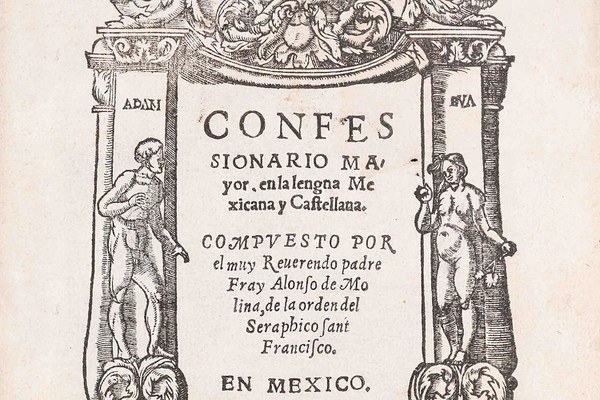By Flora Lindsay-Herrera
Dumbarton Oaks has recently acquired two works that provide insight into Nahua knowledge traditions and religious and language practices.
Fray Alonso de Molina’s Confessionario mayor, en la lengua mexicana y castellana contains important descriptions of the Nahua language and native religious traditions. Molina was brought from Spain to Mexico as a child just after Hernán Cortés’s conquest of the Aztec capital in 1521. In Mexico, Molina gained fluency in Nahuatl and served as a translator and instructor for members of the Franciscan order; he joined the order himself and was ordained in the 1530s. Molina is perhaps best known for compiling the Vocabulario en lengua castellana y mexicana (1555), which is the first known dictionary published in the Americas. Molina first published the Confessionario in 1565 to serve as a manual for imparting the sacrament of confession to Nahua-speaking communities of New Spain. A later edition, this fine 1578 copy comes bound with Molina’s Confessionario breve, en la lengua mexicana y castellana (1577). It is a significant addition to other Dumbarton Oaks holdings in early colonial-era manuals and grammars, including part two of a 1571 edition of Molina’s Vocabulario and Fray Juan Bautista’s 1599 Confessionario en lengua mexicana y castellana.
In 1570, Philip II of Spain appointed his court physician, Francisco Hernández, to travel to Mexico to study the natural history of the New World, with a focus on the medical applications of its as-yet-unknown plants. Dumbarton Oaks has acquired a rare 1628 edition of the resulting work, Rerum medicarum Novae Hispaniae thesaurus, seu, Plantarum animalium mineralium Mexicanorum historia. The core of this work is Hernández’s original research, which was subsequently reordered by Nardo Antonio Recchi and prepared for printing by Federico Cesi, the head of the Accademia dei Lincei, who also commissioned commentaries by Johannes Faber, Fabio Colonna, and Joannes Terentius. Cesi died in 1628, and only a few copies of the 1628 edition are thought to exist. An important early natural history of Mexico, this volume contains particularly valuable botanical information as well as zoological observations. It also includes numerous Nahuatl terms, which give insight into how plants were ordered and categorized in Pre-Columbian times and therefore is a valuable contribution to our collection of texts on the knowledge and language practices of the original inhabitants of Mexico.
Flora Lindsay-Herrera is Pre-Columbian Studies librarian.

